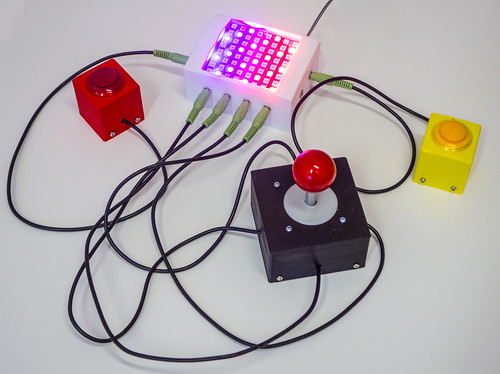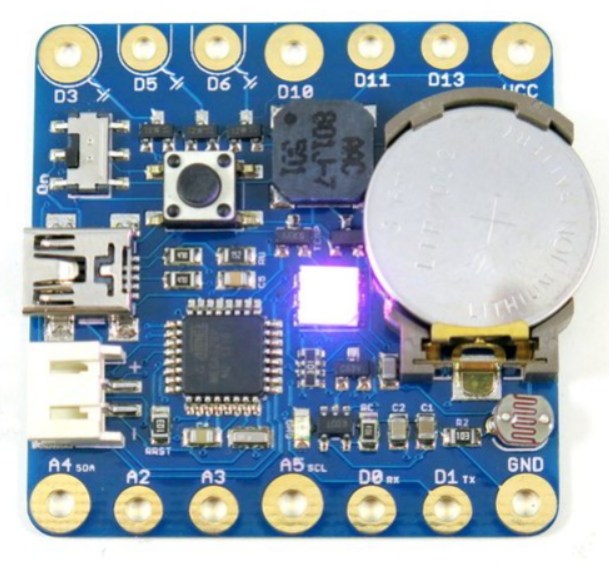Hardware at C4DI
/Robin talks radio
Tonight we had our first "proper" Hardware meetup at the C4DI. There were talks from Robin and Mike about radio hardware and one from Robert about robots. With added robot. And I stood up and waved some flashing lights around and talked about our upcoming Arduino sessions. Very, very interesting.
The first two talks, about radio communications, were amazing. It was all about the challenge of using tiny amounts of power to send signals huge distances and of designing and refining analogue circuits.
Analogue electronics has always seemed like a kind of magic to me. I'm very happy with digital signals, where things are either on or off. But analogue signals are all about signals that can take any value. The good news is that the signals obey a bunch of laws, and we can use this to build circuits that process analogue inputs in particular ways. I'm used to writing instructions for programs that tell them what to do with data that comes in. Analogue circuit design is programming with hardware. You use your maths and physics knowledge to come up with component configurations and values that should work. Then you spend ages tweaking the imperfect physical realization of your design until it does what you want.
Robin and Mike described the challenges, but also the deep satisfaction that you can get from contacting people in distant countries using hardware that you designed and made yourself. And this technology also lets you communicate when you can't get any signal bars on your shiny smartphone.
Robert then took another hardware tack. He'd brought along a robot which contained around 34 lines of program code. Not a lot perhaps, but enough to make it navigate round the room avoiding obstacles. It even backed up slowly (with appropriate warning beeper) if things got too close for comfort. Robert did a great job of explaining how what appeared to be complex behavior was actually very simple from a programming point of view.
Finally I got up and talked about our plans for future developments. We thought it might be fun to do some Arduino sessions getting to grips with programming the device, and I suggested that the Sparkfun RedBoard Starter kit would be a good basis for our work. Then something amazing happened, Ross Hamilton, C4DI regular and all round good egg, offered to sponsor our sessions to the tune of 10 RedBoard kits. This means that although it would be useful for you to have your own hardware, at a reasonable cost of 36 pounds each (less than the price of a video game) now you don't need to. I've set up a special part of this site where you can sign up for more information, and I'll post any materials that we produce up there as well.
The Configurable Joystick Project
/Some time ago Simon and I were wondering if you could make a game based around a configurable joystick. My vision for this would be of you flying your trusty spaceship through, er,space, while evil aliens shot off parts which caused your controls to break. You would be having to plug and re-plug the control elements while you were flying the ship and decide whether you needed a fire button or a back control on the joystick as you limped home.
We thought it might be a fun little project and so we made it the basis of our Global Gamejam entry. I was to 3D print the case and build the electronics and Simon and crew would come up with a game based on it.
This is not quite how it turned out.
What happened was that number one son was consigned to soldering hell, while I failed to print boxes that were the right size to fit everything in. And then at the end, we found a fundamental flaw in the circuitry that rendered the controller mostly useless. Although we did win a prize for the "Most Ambitious Failure".
But I've stuck with it. Above you can see "prototype one". And tonight I got it fully working for the first time. Each control element holds a resistor network that allows the controller to decide which socket it is plugged into. The 8x8 dot matrix screen is to be used for status displays. I've got it talking to the PC rather handily now, next step is to integrate it into the gameplay,
Great fun.
The Squarewear Arduino
/I'm getting quite keen on the Arduino devices. While they are nowhere near as powerful or easy to program as my beloved .NET Microframework platform they do come in a huge range of prices and configurations.
The Squareware 2.0 device you can see here is no exception. It is really designed for use as a wearable device. It has nice big holes that can be soldered into press-studs or connected to conductive cloth. It also has an on-board rechargable battery and recharging circuitry for an off-board one too. There are temperature and light sensors along with a buzzer and I reckon it is a pretty complete package. It also has a pair of quite beefy drivers so it can switch more current into devices like larger lights or motors.
You can pick it up from Tindie for 23 dollars, which I think is a reasonable price. Postage is reasonable too, and mine got here in only a week or so from the 'states.
I've not done anything with mine yet, but I'm sure I'll think of something...
Hardware Group at C4DI
/Tonight we had our first meeting of the new C4DI hardware group. There seem to be lots of peple who are keen on getting to grips with hardware and embedded systems, with interest in Raspberry Pi, Arduino and Gadgeteer to name a few. I took along some toys, as had other folks. Above you can see the insides of my Tagomatic device, along with some pinball machine related shenanigans which includes using an Arduino to capture messages inside the pinball table circuitry and some coils of electro-luminescent wire. That lights up and looks really cool.
Stay tuned for details of future events, this looks like it is going to be great fun, and it's not too late to sign up over at the meetup page for C4DI.






